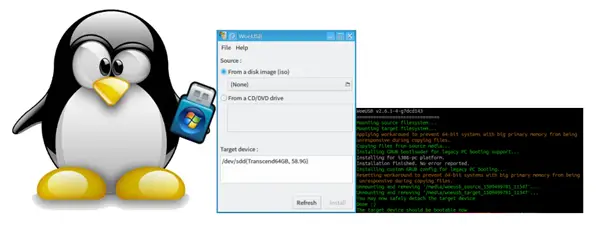The all too known process of creating Windows bootable USB/CD using the Media Creation Tool (MCT) works only from Microsoft’s operating system, Windows 11/10. Hence, the need to show you how to carry out the same action on a Linux machine. Some might ask if this tutorial is really necessary. The answer to that question is yes. This procedure to create a Windows 10 bootable media on a Linux machine will come in handy if for instance, your Windows production machine packs up and you need to provide another machine on the fly – but the machines you currently have access to are all Linux machines on which you can’t create a Windows 10 bootable media the usual way. So, it’s valuable technical know-how you should have in your kit.
Make a bootable Windows 11/10 USB on Linux
To successfully create a Windows bootable USB on Linux, you’ll need the following;
A USB flash driveA computer running Linux OSWindows 11/10 ISOWoeUSB, a simple tool that lets you create your own USB stick Windows installer from an ISO image or a real DVD.
Note: If you are booting in legacy mode (BIOS) and this procedure doesn’t work, instead of making a bootable USB, use the ISO image you downloaded and burn it to a DVD and then proceed to boot the Windows 10 machine from it after you have ensured to set your BIOS to boot from the DVD drive first.
1] First, you need to install WoeUSB
If you’re on Ubuntu or an Ubuntu-based distro such as Linux Mint, first add the PPA using the command below: If you get a message that “add-apt-repository” is not found, proceed to install it with the command below: Then re-run the above “add-apt-repository” command again. In the event the next “apt install woeusb” command doesn’t work because it can’t find the package, do this manually, with the command below: Then install WoeUSB with this command: On Fedora, install with the command: On OpenSUSE, you can get WoeUSB from here.
2] Proceed to create the bootable USB
Plug in your USB, and run WoeUSB GUI from your launch menu. If you can’t find it there, invoke it with this command: If your USB device has a filesystem on it, it will be auto-mounted by the operating system. Open your file browser and unmount it by clicking on the eject arrow next to it. Now, select the field under From a disk image (iso) and navigate to the location where you downloaded the Windows ISO image to. Next, under File system select the radio button for NTFS. Lastly, under Target device click on your USB device. Click install and wait for the process to complete. Don’t close the application or remove the USB device until you get a message that the operation has completed successfully. And that’s how you can create a Windows 11/10 bootable USB on a Linux computer. Read: How to create a Windows 11/10 Bootable USB on Mac.

